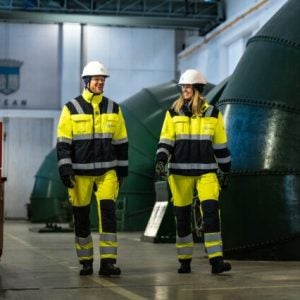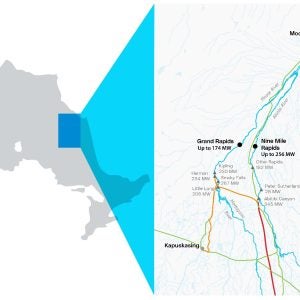 The latest issue of Dam Engineering (Volume XXXI, Issue 3) has been published:
The latest issue of Dam Engineering (Volume XXXI, Issue 3) has been published:
Displacement Monitoring in Cabril Dam Using GNSS
Miguel Rodrigues, Sergio Oliveira, Jose Nuno Lima & Jorge Proenca
Abstract: Continuous displacement monitoring is essential for the safety control of large dams. It should be based on the comparison between numerical model results and monitoring data, e.g. observed displacements using plumblines, geodetic methods or, more recently, with GNSS (Global Navigation Satellite System). For Cabril dam – the case study presented in this paper – no plumblines were installed in the central section. Thus, the displacement monitoring in this section is carried out using classic geodetic methods that do not allow continuous monitoring (only two observation campaigns per year). So, in this case, the use of GNSS was considered particularly useful as it allows continuous monitoring of displacements at the top of the central section. As Cabril dam has presented cracking problems since first filling it is important to continuously monitor several notable points, which include the point at the top of the central section. The present work focuses on the validation of the displacements obtained by GNSS at Cabril dam using a 3D finite element model developed in MATLAB, in which the horizontal cracking on the upper zone is simulated through joint elements. The 3D FE model was calibrated based on the displacements observed by plumblines (in two non-central sections), and by classic geodetic methods considering variations in hydrostatic pressure and annual temperature. The displacement evolution observed by the plumbline and geodetic methods were analyzed using HSCT (Hydrostatic, Seasonal, Creep and other Time effects) separation of effects models to facilitate the comparison process between the observed displacements and the numerical results. In this way the 3D FE model was firstly calibrated using plumbline results, and then used to validate the GNSS measurements.
Alkali-Aggregate Reactivity Evaluation of Aggregates for Application in Indian Concrete Dams
P N Ojha, Suresh Kumar, Abhishek Singh, Brijesh Singh & B N Mohapatra
Abstract: The availability of aggregates suitable for use in construction and maintenance of dams is a continuing concern to the engineering and resources-management community. In addition to the physical and mechanical properties of an aggregate, its other performance characteristics specifically depend on its mineral composition, texture and petrogenesis of the parent rock from which the aggregate originated. These properties can result in deleterious chemical reactions such as alkali-aggregate reaction when aggregate is used in concrete mixes having cements with high alkali content, which can pose a major problem for concrete structures, reducing their service life and requiring expensive repair or even replacement of the concrete. In the present study six different types of coarse aggregates, which were proposed to be used in different concrete dams, were collected from different sources across India. These coarse aggregate samples were subjected to petrographic and mineralogical examinations for evaluation of their modal compositions. The potential of alkali-aggregate reactivity (expansion potential) of all six coarse aggregate samples was evaluated using ASTM standards. The study covers the mitigation measures adopted for coarse aggregate samples which were found to be potentially reactive, as per ASTM standards, and no alternate sources of coarse aggregates were available locally for construction of the particular dam in which the aggregate was proposed to be used.
Safety Performance of Dams in Chile’s Highly Seismic Environment
Luis Valenzuela P, Ramon Verdugo A, Jose Campana Z & Carmen G Opazo A
Abstract: Chile is well-known as one of the most seismic countries in the world, responsible for more than 40% of seismic energy liberated globally. The Valdivia earthquake (EQ) of 1960, with a magnitude of Mw = 9.5, is the greatest earthquake ever registered. Recently, in February 2010, the Maule earthquake occurred with a magnitude of Mw = 8.8 which is among the world’s six largest earthquakes. This paper first presents a general description of the tectonic and seismic environment of Chile, and a summary of the most important earthquakes (M ≥ 7.5) which have occurred in the country in the last 200 years, and more detailed characteristics of three strong earthquakes in the last 35 years in the Central Northern region of Chile: Valparaiso (1985), Maule (2010) and Illapel (2015). Then a summary of the performance of large dams in Chile (height ≥ 15m) is presnted, from the end of XIX century to the present day, including moderate high dams for irrigation and water supply built between 1850 and 1930, and larger dams used for the same purpose, as well as for energy generation from 1930 to the present day. As Chile is an important mining country there are numerous tailings dams of different types for which seismic performance is also discussed. The variety of dam types used for different purposes, and built using different construction materials, constitutes an interesting scenery for the analysis of dam behaviour under high seismic loading. Although the number of concrete dams in Chile is rather limited, comments on the seismic behaviour of two arch dams and several rolled concrete dams of medium height are also presented, as well as a case of the only rockfill dam with asphalt core existing in Chile. Special attention is given to compacted gravel dams with concrete faces and two sand tailings dams, both types representing good examples of local development in dam engineering. In the case of sand tailings dams constructed using the downstream method, there is already a 200m high dam that ended operation and another designed for a height of 240m. The geotechnical characteristics and seismic behaviour of some specific dams of different types are presented as representative examples of Chilean dams for different purposes built in different periods. This paper analyses the design criteria, local dam safety legislation and dam design and construction practices in different industries. Finally, this paper ends with a discussion on the validity of different seismic stability and deformation analysis, both pseudo-static and dynamic.
Contact us for more information: For information on submitting papers or becoming a referee for Dam Engineering, please contact: Tracey Honney, Content Manager, Email: tracey.honney@progressivemediainternational.com
To order your copy, or to subscribe, please visit www.buythatmag.com/product/dam-engineering






